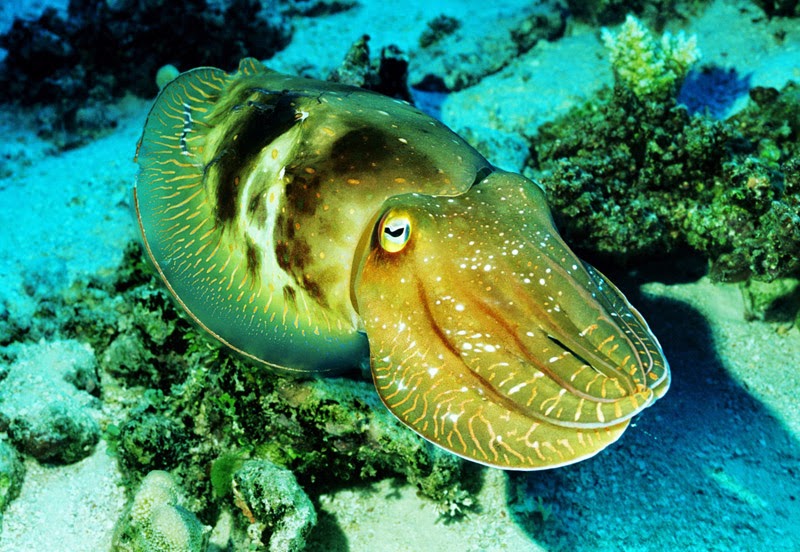Though most species are small, one amazing species can grow to 50cm long! Quite a whopper. What's more, they have one of the largest brain-to-body size ratios of any invertebrate.
An Australian Giant Cuttlefish, Sepia apama, the largest cuttlefish on Earth!
They have 10 tentacles, 2 of which are long and have a pad of powerful suckers. These are the feeding tentacles, and are used to grab prey such as crabs or fish. Once a prey item has been captured, it is paralyzed using venom in its hard beak, then eaten.
Cuttlefish can move very fast when they want to. They have flaps of skin on the sides of their body, and by undulating these flaps, the individual will be propelled forward. They also have a tube called a siphon near their head, which jets out water, allowing for quick bursts of speed.
The 'cuttle' part of the creature's name comes from the Old English name for the cuttlefish: 'cudele', which may derive from the Old Norse word 'koddi', meaning cushion, and the Middle Low German 'kudel', meaning pouch.
A porous, hard cuttlebone - the remains of an ancestral shell - is found in the center of its body. By changing the gas-to-liquid ratio inside the cuttlebone, it can regulate its buoyancy.
A cuttlebone.
Cuttlefish blood is not red like ours. Instead, it is a curious blue-green color. This is because these creatures have the protein hemocyanin, which is full of copper, instead of red, iron-containing hemoglobin. This strangely colored blood is pumped around the body by not 1, but 3 hearts! 2 hearts pump blood to a pair of gills, and the other heart pumps blood to the remaining parts of the body.
Perhaps the most interesting thing about cuttlefish is their ability to change colour at will to match its surroundings. In fact, these cephalopods are better at colour changing than the more famous chameleons. But how on Earth do Cuttlefish achieve this? They have red, brown, black, yellow, and red pigmented chromatophores, all of them in different layers of the skin. Each pigment is surrounded by an elastic sac, which can be controlled using muscles. By opening or closing the sac around certain pigments, the cuttlefish can show different levels of the different colours.
But the Cuttlefish does not stop there with its amazing mimicry. It does not just mimic the colour of its environment, but the texture! It does this by using bands of circular muscles to force pockets of water up against the skin, forming little lumps and nodes.
This tiny Cuttlefish is perfectly camouflaged against these pebbles and shells.
This stunning Flamboyant Cuttlefish (Metasepia pfefferi) exhibits its ability to change its skin texture. In this picture you can see that it has used this ability to form large flaps of skin on its body.
During the breeding season, all the males in the area will crowd together and threaten each other using either bright colors or by swimming at each other, or both. Eventually all but one dominant male will back down, and the remaining individual is free to mate with all females in the area. He does so by using a specialized tentacle to insert a sperm sack into an opening close to the female's beak. A few hours later, she will begin to lay her eggs. The male will guard her valiantly while she does so. If any large males try to interrupt, the guarding male will threaten them with the methods mentioned above. If this fails, he will attempt to bite the rivals and inject paralyzing venom into them. Not all intruding males attempt the head-on approach, though. Some camouflage themselves as a harmless female so that they can sneak past the guarding male and quickly mate with the female. The round eggs are inserted onto rocks, coral, seaweed, or sea grass. The female will die shortly after mating and laying eggs. She will mate only once in her short life.

A pair of Cuttlefish mate.
Some washed ashore Cuttlefish eggs, looking rather like grapes.
Over time, the eggs will become transparent, and the baby Cuttlefish can be seen inside. Sometimes the egg is so large for an individual that it can swim around inside it. Even at this stage they have fully developed W-shaped pupils. There is even evidence to suggest that as an adult, the Cuttlefish will prefer to prey upon creatures that it saw as a baby from its transparent egg! When the babies hatch, they will feed upon small shrimps.
A newly hatched juvenile besides an unhatched egg.
A Cuttlefish's strange pupil, looking rather like a black mustache!
I hope that you have enjoyed this week's post. Cuttlefish really are amazing little creatures!
Until next time, keep on the wild side!







Thank you so much for these pictures! Going diving soon at South West Rocks and hoping to see cuttlefish eggs in Fish Rocks Cave if this is the right time of year. Love cuttlefish.
ReplyDeleteHey great article on the cuttlefish - they are smart creatures!
ReplyDeleteCheck out my youtube video of a freedive with a friendly cuttlefish!
https://youtu.be/RY5T-erCwFo
You can also see the rest of my channel "Ocean Chan"
Thanks!